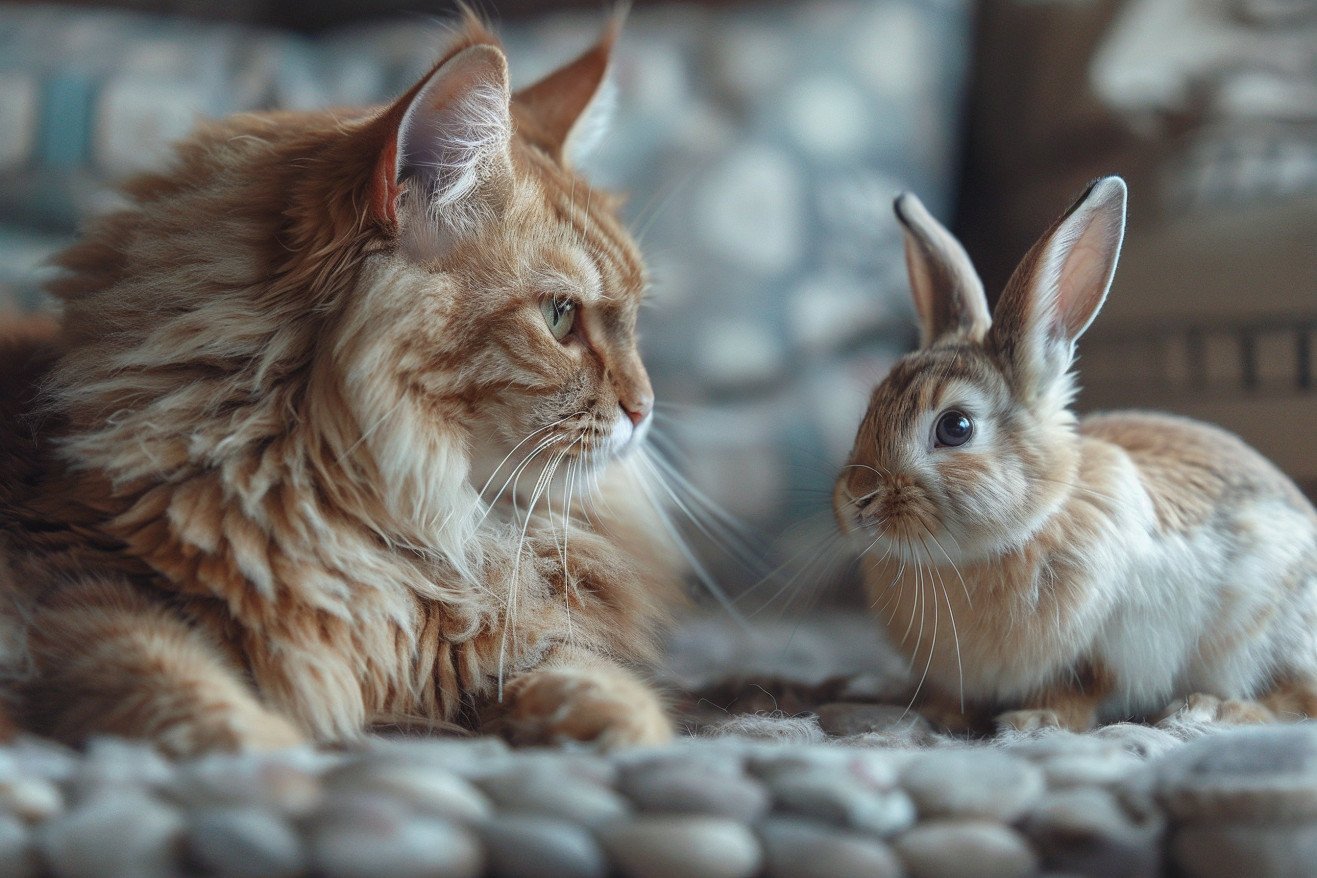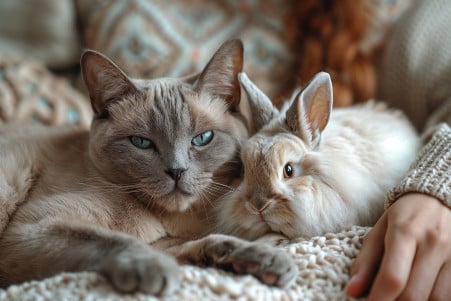Do Cats Eat Rabbits? How to Keep Your Cat and Pet Rabbit Safe
15 April 2024 • Updated 13 April 2024

Cats and rabbits can become friends, but there are some dangers that come with a cat's natural instincts that rabbit owners should know about. Cats are obligate carnivores, which means that their bodies require a diet that includes meat. While domestic cats are fed commercial cat food, feral and free-roaming cats hunt and eat small animals like rabbits, mice, birds and bugs to get the nutrients they need.
While it's not pleasant to think about our pet cats eating rabbits, we'll explore the scientific research on cat hunting and diet. With the help of animal behaviorists, veterinarians and wildlife biologists, we'll find out if cats "need" to eat rabbits, the dangers of hunting behavior, and what pet owners can do to make sure their cats and rabbits are safe together.
Do cats eat rabbits?
How to Introduce Cats and Rabbits
When introducing cats and rabbits, it's important to take into account the ages, temperaments, and breeds of the animals. For example, a young, energetic kitten or puppy may not be safe for a free-roaming rabbit, according to Animal Friends, Inc. On the other hand, a calm, older cat or dog that doesn't have a strong prey drive may be a good candidate for living with a rabbit.
The introduction process should be slow and methodical, and it should start with "scent handshakes" that involve transferring scents between the animals before they meet, according to wikiHow Pet. The rabbit should be kept in a secure environment like a cage at first, and then supervised visits should be allowed where the cat can see and smell the rabbit but can't physically get to it. This process of scent familiarization and controlled visits will help the animals get used to one another.
Vaccinations, spaying/neutering, and close supervision are also important, especially during the initial introduction period. The Brook Vet notes that rabbits should be introduced to cats and dogs slowly because rabbits are prey animals and the cats and dogs need to be taught that the rabbit isn't something to chase or eat. Separate housing, feeding, and toileting areas should be maintained even if the animals seem to be getting along.
It's also important to have realistic expectations—while rabbits and cats may learn to tolerate one another, they're unlikely to become best friends. As Humane Society NT points out, don't expect your rabbit and cat to be best friends, especially if you're not willing to put in the time and effort to make it happen. Ongoing supervision is important to make sure that the pets are safe and to prevent the cat from triggering its prey drive toward the rabbit. However, with time and patience, it's possible for these pets to live together in harmony.
Why Do Cats Hunt Rabbits?
Cats have a natural instinct to hunt and kill small animals, including rabbits. According to Hepper, cats, especially feral cats, are the number one killer of birds and mammals in the United States, with an estimated 1-4 billion birds and 6-22 billion mammals falling victim to them each year.
The likelihood of a cat successfully hunting a rabbit depends on several factors, according to Berry Patch Farms. Cats prefer smaller prey that's easier to catch, and healthy adult rabbits are generally too fast and nimble for the average domestic cat to catch and kill. However, kittens and injured rabbits are more likely to be targeted by cats.
Although cats may stalk and chase rabbits, they are unlikely to actually catch and kill them, as rabbits' speed and agility make them difficult to catch, as pointed out by Home & Roost. However, a cat with a strong hunting instinct will definitely try to hunt and kill a rabbit, especially if the rabbit is smaller than the cat.
In addition, eating rabbits can be dangerous for cats, as rabbits can carry tularemia, a potentially deadly bacterial infection, according to Hepper. Cats can get tularemia by eating infected rabbits, drinking contaminated water, or being bitten by ticks, deer flies, or chiggers that carry the bacteria.
Personal stories posted on Pets Stack Exchange recount cats successfully catching and killing rabbits, and in some cases, bringing live rabbits home to their owners. However, these stories suggest that a cat's ability to catch and kill a rabbit is relatively rare.
How Cats Impact Rabbit Populations
The number of mammals killed by domestic cats in the United States is shocking. A study in Nature Communications estimates that free-ranging domestic cats in the contiguous United States kill between 6.3 and 22.3 billion mammals per year, with 89% of the mortality caused by un-owned cats.
This has a disproportionate impact on native species in suburban and rural areas, where 75-100% of the mammals killed by cats are native mice, shrews, voles, squirrels and rabbits, as opposed to the non-native rodents that are more common in urban areas. This was shown in the research of Llewellyn and Uhler and Kays and DeWan.
The high number of mammals killed by cats has led to concerns about the impact on threatened and endangered species, especially on islands where small populations are particularly at risk. As pointed out by Crooks and Soule, cat predation has been implicated in the global extinction of at least 63 species and currently threatens at least 367 other species with extinction.
However, the impact of trap-neuter-return (TNR) programs on cat populations and wildlife mortality is still a matter of significant controversy. According to Longcore et al. and Lepczyk et al., there is no scientific evidence from peer-reviewed studies to support the claims that TNR programs are effective, and alternative approaches may be necessary to protect vulnerable wildlife.
How to Prevent Cats From Hunting Rabbits
Preventing cats from hunting wild and domestic rabbits will require a multifaceted approach. According to PETA, the most humane and effective solutions will focus on making a particular area less attractive to rabbits, rather than removing the animals. This can be done by planting deterrent plants such as lavender, catnip, or marigolds around the area in question.
For wild rabbits, Pennsylvania State University Extension suggests that maintaining the right kind of habitat is key. This can be done by mowing, disking, or brush chopping to prevent the land from becoming overgrown with dense forest. In addition, limiting livestock grazing and planting food plots and hedgerows can help to ensure that the land has the right mix of grass, forb, and shrub cover that cottontails need.
To prevent domestic rabbits from becoming prey, the Humane Society of the United States recommends installing a 2-foot tall chicken wire fence, dug 6-8 inches into the ground to prevent burrowing. Commercial tree wrap or plastic tree guards can also be used to protect plants from being eaten by rabbits. In addition, scare tactics, such as scare tape or balloons, can be used to keep rabbits away from certain areas.
That said, the RSPCA notes that while some predation deterrent devices may reduce hunting success, their effectiveness is generally limited. The best way to prevent hunting is to keep cats safely contained at home, either by choice or through the implementation of cat confinement laws. This will help to protect both cats and the wildlife they may hunt.
Conclusion: Can Cats and Rabbits Live Together?
The relationship between cats and rabbits is a complex one, balancing the natural predatory instincts of felines with the need to protect vulnerable rabbit populations. While outright attacks are not the norm, cat owners must remain vigilant and take necessary precautions to facilitate peaceful coexistence.
Introducing cats and rabbits at a young age, ensuring compatible temperaments, and providing separate living spaces are key to establishing a safe and harmonious dynamic. Responsible pet ownership, including spaying/neutering and proper containment, is essential to prevent the devastating ecological impacts of cat predation on small mammal species.
By understanding the behaviors and needs of both animals, and implementing practical strategies to deter hunting, cat and rabbit owners can find a balance that allows these unlikely companions to coexist peacefully. With care and consideration, these two very different pets can learn to tolerate, and even accept, each other's presence in the home.


